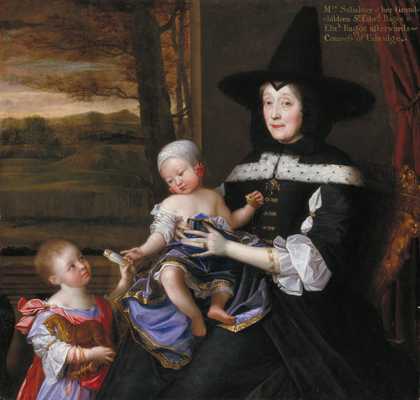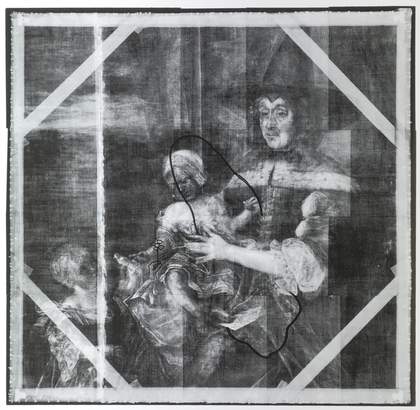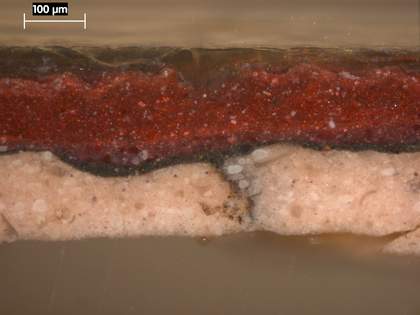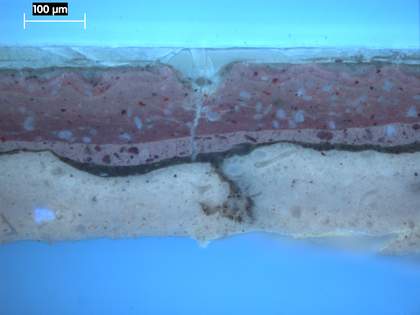
Fig.1
John Michael Wright 1617–1694
Portrait of Mrs Salesbury with her Grandchildren Edward and Elizabeth Bagot 1675–6
Tate
T06750

Fig.2
X-radiograph of Portrait of Mrs Salesbury with her Grandchildren Edward and Elizabeth Bagot 1675–6. The seam between the two pieces of canvas is the bright white line running to top to bottom on the left. The outline of the original swaddled baby is annotated in black
This painting is in oil paint on canvas measuring 1295 x 1336 mm (fig.1). The x-radiograph shows that the canvas support is made up of two pieces sewn together at a seam running vertically through the body of the little boy on the left (fig.2). As described in Mary Bustin’s technical study of this painting, the artist joined together two discarded paintings to make the square canvas support for this painting; the main piece, which houses the portrait of Mrs Salesbury and the baby Elizabeth, originally depicted a lady in a feathered headdress, now only very faintly discernible in the X-radiograph.1 Both pieces of canvas are plainly woven and are of medium weight.

Fig.3
Cross-section thorough Edward’s red cloak and lilac coloured gown where it goes over the dark background. Photographed at x200 magnification. From the bottom upwards: pink ground; brown paint of background; blue paint of gown overlaid with red paint to create purple; pink highlight of the cloak; discoloured varnish

Fig.4
The same cross-section as in fig.3, photographed at x200 magnification in ultraviolet light
The ground is salmon pink colour (figs.3–4). This colour is the same in both pieces of canvas; the trough created by the seam was filled with similarly though slightly differently coloured paint.
The picture underwent several alterations during the course of painting; as Mary Bustin reveals in her study, originally the baby was a swaddled infant held in her grandmother’s arms and her brother Edward proffered a flower rather than the doll we now see (fig.2). Wright used the following principal pigments in his painting: lead white, smalt, ultramarine, red lake, vermilion, yellow ochre, charcoal black, verdigris, green earth and umbers.2 For the costly lake pigments and the ultramarine, Wright added £3 10s to the overall cost of the painting. When the children’s father, who commissioned the painting, complained at the extra cost, Wright explained that, ‘it is customary among artists to have these colours payd particularly by themselves’. He had already explained that, ‘I could have saved that charge and given you colours which would have seemed as rich at the present but would not have lasted as these will’.3 Wright used the ultramarine in a glaze on top of opaque blue containing smalt (a much cheaper pigment) for the bearing cloth on which the baby is seated.
When Wright was in Rome in the 1650s, he met Richard Symonds, an English traveller, who wrote later that Wright, ‘always uses Vernish mixt with his colours’.4 The presence of varnish in the binding medium may explain the fluorescence of the dark paint (not illustrated).
The present varnish is a modern one made of polycyclohexanone resin.5
January 2023
